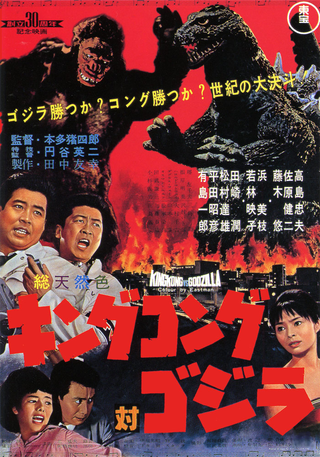
King Kong vs. Godzilla is a 1962 Japanese kaiju film directed by Ishirō Honda, with special effects by Eiji Tsuburaya. Produced and distributed by Toho Co., Ltd, it is the third film in both the Godzilla and King Kong franchises, as well as the first Toho-produced film featuring King Kong. It is also the first time that each character appeared on film in color and widescreen. The film stars Tadao Takashima, Kenji Sahara, Yū Fujiki, Ichirō Arishima, and Mie Hama, with Shoichi Hirose as King Kong and Haruo Nakajima as Godzilla. In the film, Godzilla is reawakened by an American submarine and a pharmaceutical company captures King Kong for promotional uses, culminating in a battle on Mount Fuji.
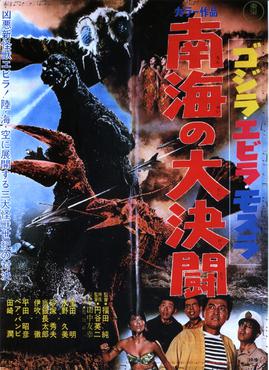
Ebirah, Horror of the Deep is a 1966 Japanese kaiju film directed by Jun Fukuda and produced and distributed by Toho Co., Ltd. The film stars Akira Takarada, Kumi Mizuno, Akihiko Hirata and Eisei Amamoto, and features the fictional monster characters Godzilla, Mothra, and Ebirah. It is the seventh film in the Godzilla franchise, and features special effects by Sadamasa Arikawa, under the supervision of Eiji Tsuburaya. In the film, Godzilla and Ebirah are portrayed by Haruo Nakajima and Hiroshi Sekita, respectively.
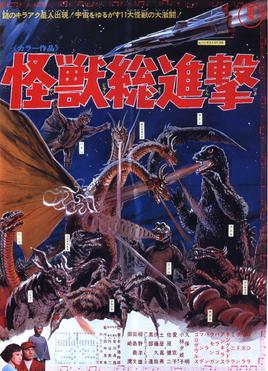
Destroy All Monsters is a 1968 Japanese epic kaiju film directed by Ishirō Honda, with special effects directed by Sadamasa Arikawa and supervised by Eiji Tsuburaya. The film, which was produced and distributed by Toho Co., Ltd, is the ninth film in the Godzilla franchise, and features eleven monster characters, including Godzilla, Mothra, Rodan, King Ghidorah, Anguirus, and Minilla. The film stars Akira Kubo, Jun Tazaki, Yukiko Kobayashi and Yoshio Tsuchiya.
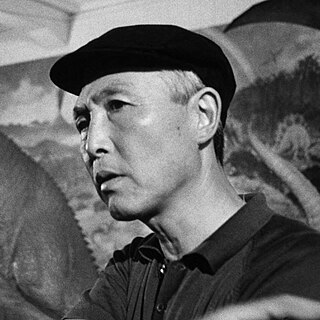
Ishirō Honda was a Japanese filmmaker who directed 46 feature films in a career spanning five decades. He is acknowledged as the most internationally successful Japanese filmmaker prior to Hayao Miyazaki and one of the founders of modern disaster film, with his films having a significant influence on the film industry. Despite directing many drama, war, documentary, and comedy films, Honda is best remembered for directing and co-creating the kaiju genre with special effects director Eiji Tsuburaya.
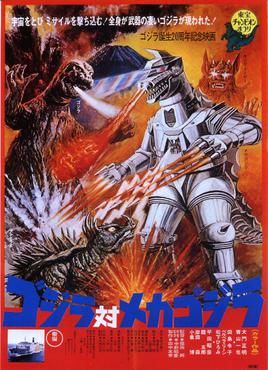
Godzilla vs. Mechagodzilla is a 1974 Japanese action-adventure kaiju film directed by Jun Fukuda, with special effects by Teruyoshi Nakano. Distributed by Toho and produced under their effects subsidiary Toho–Eizo, it is the 14th film of the Godzilla franchise, and features the fictional monster characters Godzilla, Anguirus, and King Caesar, along with the mecha character Mechagodzilla. The film stars Masaaki Daimon, Kazuya Aoyama, Gorō Mutsumi, and Akihiko Hirata, with Isao Zushi as Godzilla, Satoru Kuzumi as both Anguirus and King Caesar, and Kazunari Mori as Mechagodzilla. The film marks the first appearances of King Caesar and Mechagodzilla in the franchise.

All Monsters Attack is a 1969 Japanese kaiju film directed by Ishirō Honda, written by Shinichi Sekizawa, and produced by Tomoyuki Tanaka. The film, which was produced and distributed by Toho Co., Ltd, is the tenth film in the Godzilla series, and features the fictional monster characters Godzilla, Minilla, and Gabara. The film stars Tomonori Yazaki, Kenji Sahara, and Hideyo Amamoto, with special effects by Honda and Teruyoshi Nakano, and features Haruo Nakajima as Godzilla, Marchan the Dwarf as Minilla, and Yasuhiko Kakuyuki as Gabara.

Invasion of Astro-Monster is a 1965 kaiju film directed by Ishirō Honda, with special effects by Eiji Tsuburaya. It is the sixth film in the Godzilla franchise and Shōwa period. The film was a Japanese-American co-production; it was the second collaboration between Toho Co., Ltd. and UPA. The film stars Akira Takarada, Nick Adams, Kumi Mizuno, Akira Kubo, and Yoshio Tsuchiya, with Haruo Nakajima as Godzilla, Masaki Shinohara as Rodan, and Shoichi Hirose as King Ghidorah. In the film, aliens plead with humanity to borrow Godzilla and Rodan to defeat King Ghidorah, only to betray the humans and unleash the monsters on the Earth.

Ghidorah, the Three-Headed Monster is a 1964 Japanese kaiju film directed by Ishirō Honda, with special effects by Eiji Tsuburaya. Produced and distributed by Toho Co., Ltd., it is the fifth film in the Godzilla franchise, and was the second Godzilla film produced that year, after Mothra vs. Godzilla. The film stars Yosuke Natsuki, Hiroshi Koizumi, Akiko Wakabayashi, with Haruo Nakajima as Godzilla, Masanori Shinohara as Rodan, and Shoichi Hirose as King Ghidorah. In the film, an extraterrestrial from Venus, possessing the body of a princess, warns humanity of the pending destruction by the alien-dragon King Ghidorah, with Godzilla, Rodan, and Mothra being their last hope for survival.

Frankenstein vs. Baragon is a 1965 kaiju film directed by Ishirō Honda, with special effects by Eiji Tsuburaya. The film stars Nick Adams, Kumi Mizuno and Tadao Takashima, with Koji Furuhata as Frankenstein and Haruo Nakajima as Baragon. An international co-production of Japan and the United States; it was the first collaboration between Toho Co., Ltd and Henry G. Saperstein. In the film, scientists investigate the origins of a mysterious boy and his resistance to radiation that makes him grow to monstrous size, while a second monster ravages the countryside.
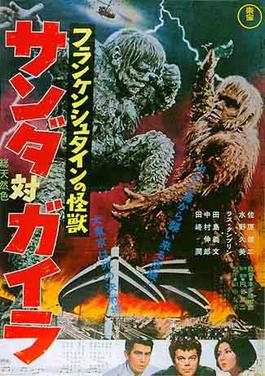
The War of the Gargantuas is a 1966 kaiju film directed by Ishirō Honda, with special effects by Eiji Tsuburaya. Referred by film historian Stuart Galbraith IV as a "quasi–sequel" to Frankenstein vs. Baragon, the film was a Japanese-American co-production; it was the third and final collaboration between Toho Co., Ltd and Henry G. Saperstein. The film stars Russ Tamblyn, Kumi Mizuno and Kenji Sahara, with Yû Sekida as Sanda and Haruo Nakajima as Gaira. In the film, scientists investigate the sudden appearance of two giant hairy humanoid monsters that culminates in a battle in Tokyo.
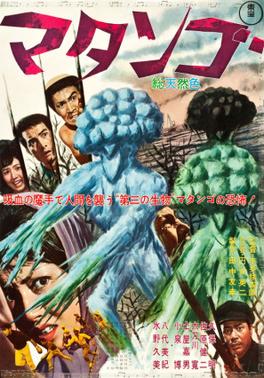
Matango (マタンゴ) is a 1963 Japanese horror film directed by Ishirō Honda. The film stars Akira Kubo, Kumi Mizuno and Kenji Sahara. It is partially based on William Hope Hodgson's short story "The Voice in the Night" and is about a group of castaways on an island who are unwittingly altered by a local species of mutagenic mushrooms.
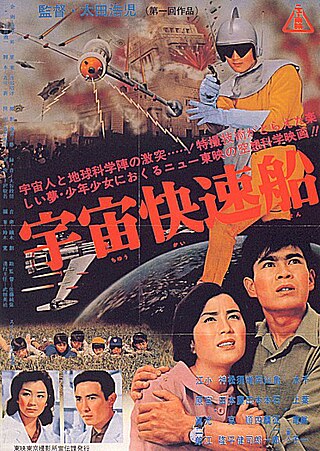
Invasion of the Neptune Men is a 1961 superhero film produced by Toei Company Ltd. The film stars Sonny Chiba as Iron Sharp.

Varan the Unbelievable is a 1958 Japanese kaiju film directed by Ishirō Honda, with special effects by Eiji Tsuburaya. Produced and distributed by Toho Co., Ltd, it stars Kōzō Nomura, Ayumi Sonoda, and Koreya Senda, with Haruo Nakajima as Varan. In the film, a reporter's investigation into two mysterious deaths in Japan's mountains leads to the discovery of a giant lake monster, wrecking its way towards civilization.

Mothra is a 1961 Japanese kaiju film directed by Ishirō Honda, with special effects by Eiji Tsuburaya. Produced and distributed by Toho Co., Ltd, it is the first film in the Mothra franchise. The film stars Frankie Sakai, Hiroshi Koizumi, Kyōko Kagawa, Jerry Ito, and The Peanuts. In the film, an expedition to an irradiated island brings civilization in contact with a primitive native culture. When one sensationalist entrepreneur tries to exploit the islanders, their ancient deity arises in retaliation.

The Human Vapor is a 1960 Japanese science fiction film directed by Ishirō Honda, with special effects by Eiji Tsuburaya. Produced and distributed by Toho Co., Ltd., it is the third and final film in the Transforming Human Series. In the film, a scientific experiment goes awry and turns its subject into an unstoppable gaseous mutant who takes advantage of his abilities and commits ruthless crimes.

Latitude Zero is a 1969 tokusatsu science fiction film directed by Ishirō Honda, with special effects by Eiji Tsuburaya. An international co-production of Japan and the United States, it stars Joseph Cotten, Cesar Romero, Akira Takarada, Masumi Okada, Richard Jaeckel, Patricia Medina, and Akihiko Hirata.

Ultraman: Monster Movie Feature is a 1967 Japanese superhero kaiju film directed by Hajime Tsuburaya, with special effects by Koichi Takano. Produced by Tsuburaya Productions and distributed by Toho Co., Ltd., it is the first film in the Ultraman franchise, consisting entirely of re-edited material from the original series. In the film, an extraterrestrial defends Earth from giant monsters who pose a threat to humanity.

The Lost World of Sinbad is a 1963 Japanese drama action film directed by Senkichi Taniguchi, with special effects by Eiji Tsuburaya. The film stars Toshiro Mifune and Mie Hama.


















